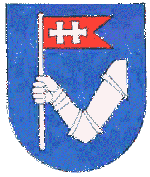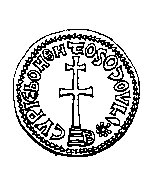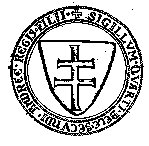The roots of double cross stretches back to early Middle Ages in the Byzant Empire where appeared for the first time on the golden coins of Emperor Theophilus (829 - 842). This kind of the cross used also his son Michael III on his coins later and he sent to our territory Constantin and Methodius on the request of Rastislav. They brought double cross here in Great Moravia. After the fall of GM, the old Hungarians adopted double cross from the Slavs and first appearances can be found on the coins Nitra duke Belo (1048 - 1060) who became later king Belo I (1061 - 1063). Those coins were mint in Nitra. In 12th century the use of coat of arms came into being and several hungarian kings had double cross on their escutcheon as a figure. One of them was king Belo IV (1235 - 1271), who supported development of towns and also granted the right to use royal attribute, eg the double cross. The double cross occurs also on coat of arms of another Slovak towns, Topoľčany, Žilina, Šurany, Zvolen etc. and in general, it was considered as a sign of Upper Hungary, hence Slovakia.


